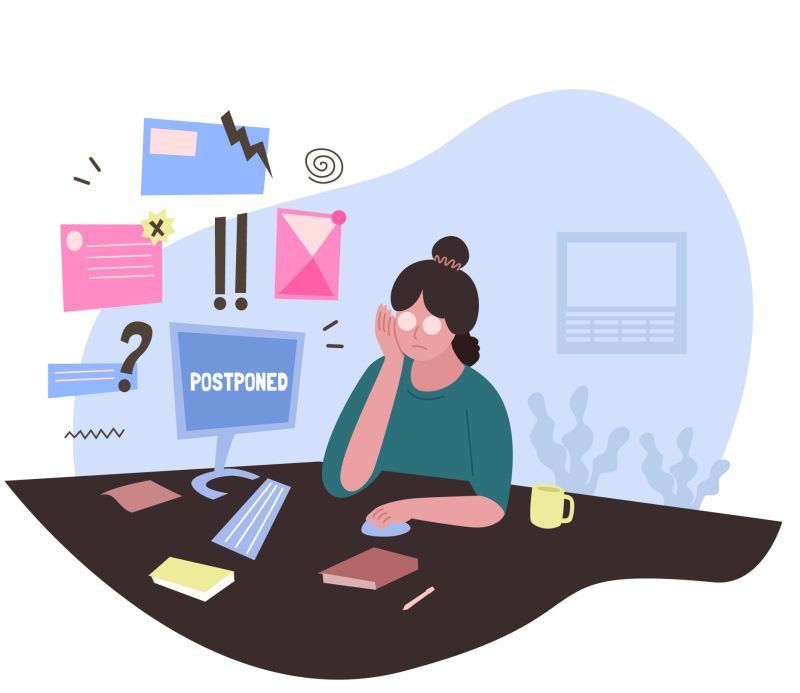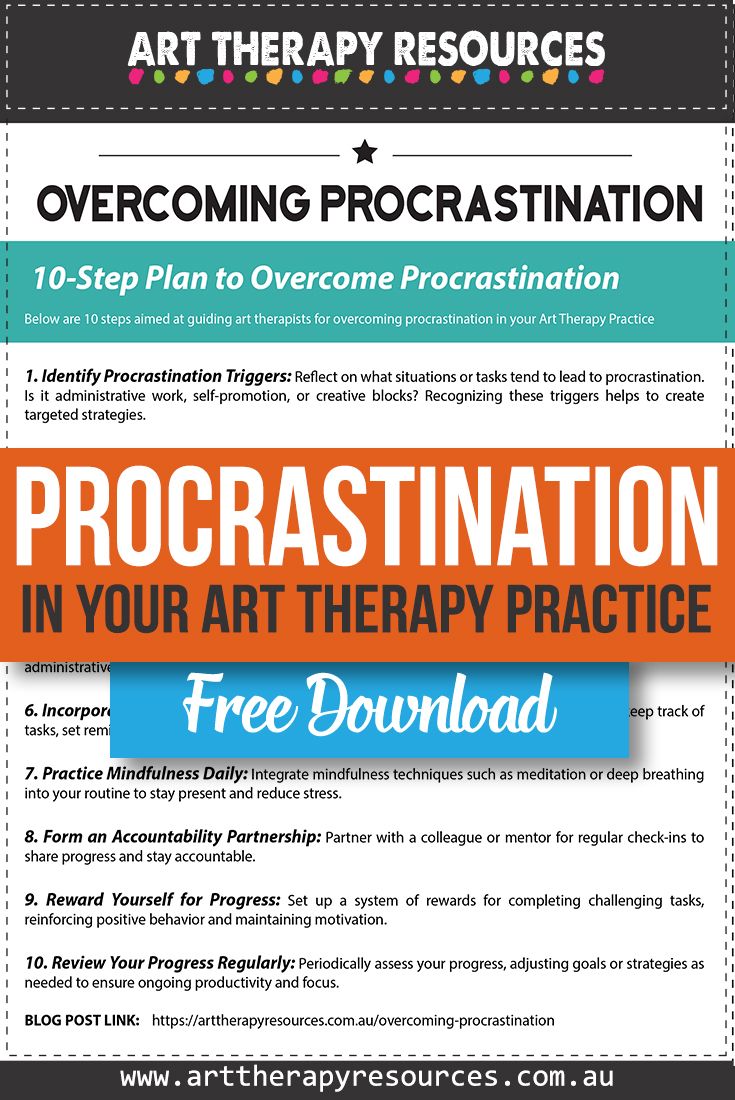THIS POST INCLUDES:
1. Understanding Procrastination
2. Strategies for Procrastination
3. Tools to Combat Procrastination
4. Navigating Procrastination in Client Work
5. Free Download 10 Step Plan for Procrastination
UNDERSTANDING PROCRASTINATION

Procrastination is a challenge that impacts many professionals, including art therapists. It can manifest in various ways, from delaying paperwork to avoiding crucial business decisions, ultimately stalling the growth of a private practice. The key to overcoming procrastination lies in understanding the underlying causes and implementing tailored strategies to maintain focus and momentum. This article provides insights into the nature of procrastination and actionable techniques to empower art therapists to build their practice with confidence.
Procrastination isn’t just about avoiding tasks; it often emerges from the emotional and creative demands of the profession. Art therapists, like all creatives, thrive in environments where flexibility and exploration are encouraged. However, running a private practice requires a balance between creative freedom and structured, consistent business management. Procrastination can result from feeling overwhelmed by administrative tasks that seem disconnected from the core mission of helping clients heal through art. Additionally, therapeutic work itself can be emotionally taxing, leading to burnout or avoidance behaviors.
Recognizing that procrastination affects every aspect of an art therapy practice—from client management to business growth—enables therapists to begin addressing it. Acknowledging its presence in both the creative and business aspects of the profession is the first step toward implementing effective solutions.
Challenges Faced by Art Therapists
Managing the emotional intensity of client sessions, keeping up with administrative responsibilities, marketing the practice, and maintaining work-life balance are all significant challenges. These challenges can lead to avoidance of tasks perceived as too difficult, time-consuming, or emotionally draining. For example, therapists might delay filing insurance claims or updating client notes, which can lead to a buildup of incomplete work and increased stress over time.
Procrastination is often compounded by perfectionism, self-doubt, or fear of failure. Art therapists might delay finishing an important project or launching a new initiative because of concerns about its reception or impact. This section emphasizes the importance of identifying and addressing these psychological barriers to minimize procrastination in both creative and administrative tasks.
The Procrastination Paradox: Creativity vs. Productivity
Creativity and productivity can sometimes feel at odds, leading to what is often referred to as the “procrastination paradox.” Creativity thrives in an unhurried environment where ideas can evolve and develop over time. This is particularly true for art therapists, who rely on the creative process to foster healing and insight in their clients. However, running a private practice requires structured productivity, especially when it comes to managing client loads, maintaining accurate records, and ensuring financial stability.
Balancing the need for creative exploration with the demands of productivity can be challenging. Therapists may delay administrative tasks to prioritize creative endeavors or self-care, but this often results in backlogs that require urgent attention later. Striking the right balance involves establishing boundaries between creative time and structured work periods. Art therapists can still allow space for creativity while ensuring that the necessary business tasks are completed in a timely manner.
STRATEGIES FOR PROCRASTINATION
Setting Professional and Business Goals
Setting clear, well-defined goals is crucial for overcoming procrastination. Art therapists often face ambiguity in their professional lives, which can make it difficult to prioritize tasks. By setting specific, measurable, attainable, relevant, and time-bound (SMART) goals, therapists can create a roadmap that keeps them focused on both their therapeutic work and the business side of their practice.
For example, a therapist might set a goal to increase their client base by 10% over six months or to spend two hours a week marketing their services. Clear goals provide direction and purpose, making it easier to avoid procrastination. Breaking larger goals down into smaller, actionable steps also ensures steady progress without feeling overwhelmed.
Breaking Down Goals into Manageable Tasks: The Power of Micro-Progress
Procrastination often arises when tasks seem too large or complex to complete. By breaking down big tasks into smaller, more manageable pieces, art therapists can reduce the sense of overwhelm and make steady progress. This concept of “micro-progress” encourages individuals to focus on one small task at a time, building momentum and reducing the temptation to delay.
For instance, if a therapist is preparing for a professional development workshop, they can start by researching the topic, drafting an outline, and then developing each section incrementally. Each small task, when completed, contributes to the overall goal and gives a sense of accomplishment, helping to combat the feeling of paralysis that often accompanies large projects.
Creating a Structured Schedule: Time Blocking for Success
A structured schedule provides a framework for success, helping therapists avoid procrastination by assigning dedicated time for each activity. Time blocking is a popular technique where therapists allocate specific blocks of time to various tasks throughout their day. For example, one block could be set aside for client sessions, another for administrative work, and another for creative reflection or self-care.
This method ensures that important tasks receive the attention they deserve and prevents them from being overshadowed by less critical activities. Time blocking also encourages therapists to stick to their schedule, reducing the likelihood of tasks piling up or being delayed. By committing to a routine, art therapists can balance creativity, client work, and business management more effectively.
TOOLS TO COMBAT PROCRASTINATION
Utilizing Task Management Apps: Streamlining Productivity
Task management apps are useful tools for staying organized and on track. Apps like Asana, Trello, or Todoist allow therapists to create task lists, set deadlines, prioritize work, and track progress. These apps are particularly helpful for keeping track of multiple projects, client records, and administrative tasks, all of which can easily become overwhelming without proper organization.
By using these apps, art therapists can create a visual representation of their workload, which helps prevent procrastination by breaking tasks down into manageable pieces and setting reminders for upcoming deadlines. This digital accountability keeps therapists focused and minimizes the chances of delaying important work.
Mindfulness and Procrastination: Cultivating Present-Centered Focus
Mindfulness is a powerful tool for combating procrastination because it encourages present-centered awareness. When art therapists practice mindfulness, they become more attuned to their thoughts and feelings, making it easier to recognize when they are avoiding tasks or becoming distracted. Mindfulness practices like meditation, deep breathing, or mindful movement can help therapists reduce stress and maintain focus.
By incorporating mindfulness into their daily routine, therapists can stay grounded, enhance their concentration, and approach tasks with a calm and centered mindset. This allows them to engage more fully with their work and reduce the emotional triggers that often lead to procrastination.
Accountability Partnerships: Collaborative Support for Success
One of the most effective ways to combat procrastination is through accountability partnerships. Working alongside a colleague, mentor, or even a friend provides external motivation and support. Art therapists can check in regularly with their accountability partner, sharing their progress and discussing any challenges they face. These regular check-ins create a sense of responsibility and help therapists stay on track with their goals.
Accountability partnerships also offer opportunities for collaboration and feedback, which can enhance both professional development and business growth. Knowing that someone else is monitoring their progress can push therapists to overcome procrastination and take action on their goals.
NAVIGATING PROCRASTINATION IN CLIENT WORK
Procrastination in Client Interventions: Addressing Therapeutic Challenges
Procrastination can extend beyond administrative tasks and into the therapeutic work itself. Art therapists may find themselves hesitating to explore difficult topics with clients or delaying certain interventions due to fear of failure or uncertainty. This type of procrastination can impact the effectiveness of the therapy, leading to stagnation in the client’s progress.
To address this, art therapists should regularly reflect on their client work, identifying areas where they might be avoiding necessary steps. Supervision and peer consultation can be valuable in gaining insight and support for these challenges. By proactively planning interventions and setting clear goals for client progress, therapists can mitigate procrastination in their clinical work, ensuring that their clients receive the most effective care possible.
FREE DOWNLOAD: 10 Step Plan
SIGN UP below to gain access to our RESOURCE LIBRARY and download the FREE 10-Step Plan to Overcome Procrastination.

BUILD YOUR ART THERAPY REFERENCE MATERIALS:
Pin this image to your Pinterest board.

SHARE KNOWLEDGE & PASS IT ON:
If you’ve enjoyed this post, please share it on Facebook, Twitter, Pinterest. Thank you!


